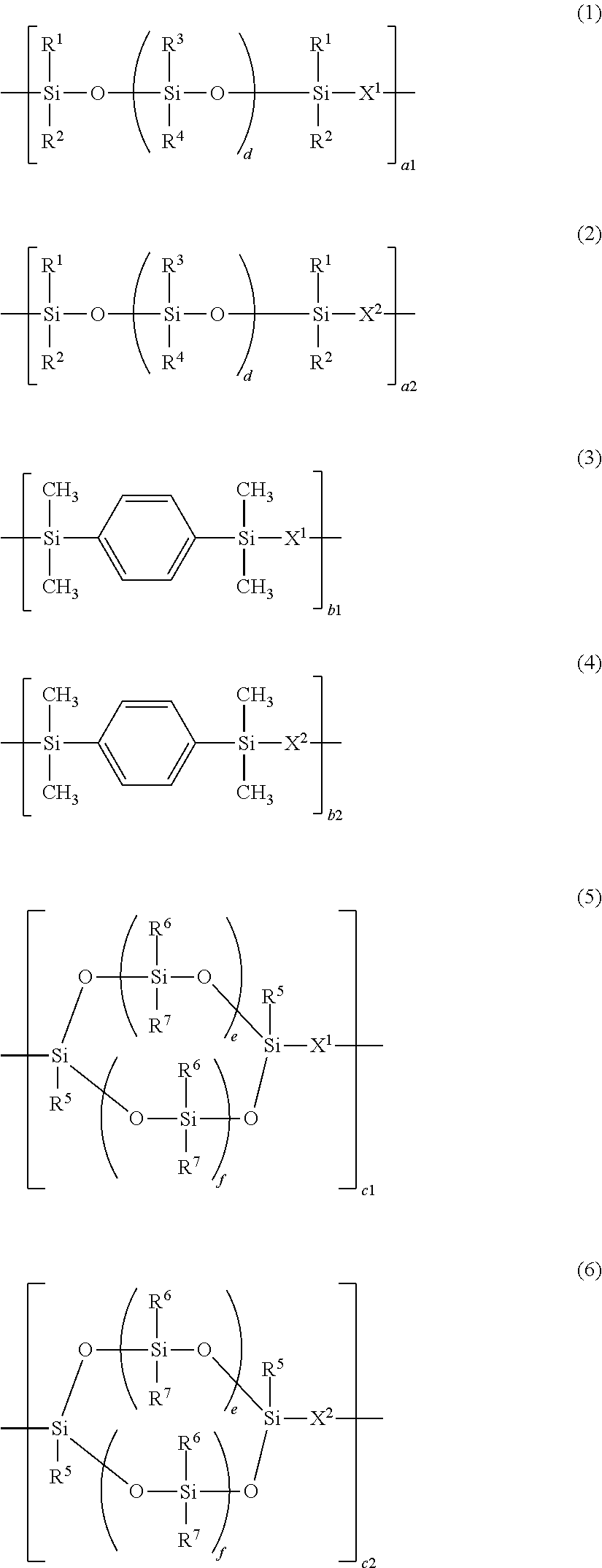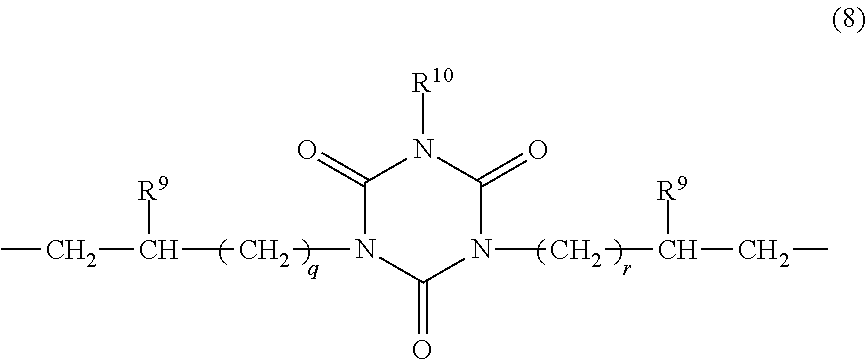Epoxy-containing, isocyanurate-modified silicone resin, photosensitive resin composition, photosensitive dry film, laminate, and pattern forming process
a technology of isocyanurate and silicone resin, which is applied in the direction of photomechanical equipment, coatings, instruments, etc., can solve the problems of inability to meet the microprocessing requirements of advanced optical devices, inability to clear the light resistance level inability to achieve the level of light resistance needed for advanced optical devices, etc., to achieve easy processing, fine size patterns, and easy application
- Summary
- Abstract
- Description
- Claims
- Application Information
AI Technical Summary
Benefits of technology
Problems solved by technology
Method used
Image
Examples
example 1-1
[0194]Synthesis of Resin A-1
[0195]A flask equipped with a stirrer and thermometer was charged with 55.3 g (0.02 mol) of Compound (S-2), 4.8 g (0.02 mol) of 1,3,5,7-tetramethylcyclotetrasiloxane, 9.7 g (0.05 mol) of 1,4-bis(dimethylsilyl)benzene, 500 g of toluene, and 0.5 g of a 2 wt % ethanol solution of chloroplatinic acid. With the flask in an oil bath, the solution was stirred at an internal temperature of 70° C. Thereafter, 7.4 g (0.06 mol) of 1,2-epoxy-4-vinylcyclohexane and 8.9 g (0.04 mol) of 1,3-diallyl-5-methyl-1,3,5-triazine were added dropwise over 20 minutes. At the end of dropwise addition, the reaction solution was stirred at 90° C. for 3 hours. After the completion of reaction, the reaction solution was heated in vacuum (50° C., 1 mmHg) on a rotary evaporator until any distillate was no longer detected, obtaining 75 g of Resin A-1. Resin A-1 had a Mw of 10,200. On 1H-NMR analysis, the structure of Resin A-1 was found to contain recurring units having formulae (2), (4)...
example 1-2
[0196]Synthesis of Resin A-2
[0197]A flask equipped with a stirrer and thermometer was charged with 12.3 g (0.02 mol) of Compound (S-1), 16.9 g (0.07 mol) of 1,3,5,7-tetramethylcyclotetrasiloxane, 3.9 g (0.02 mol) of 1,4-bis(dimethylsilyl)benzene, 500 g of toluene, and 0.5 g of a 2 wt % ethanol solution of chloroplatinic acid. With the flask in an oil bath, the solution was stirred at an internal temperature of 70° C. Thereafter, 19.8 g (0.16 mol) of 1,2-epoxy-4-vinylcyclohexane, 11.2 g (0.06 mol) of 1,3-divinyl-1,1,3,3-tetramethylpropanedisiloxane, 5.3 g (0.02 mol) of 1,3-diallyl-5-glycidyl-1,3,5-triazine, and 4.5 g (0.02 mol) of 1,3-diallyl-5-methyl-1,3,5-triazine were added dropwise over 20 minutes. At the end of dropwise addition, the reaction solution was stirred at 90° C. for 3 hours. After the completion of reaction, the reaction solution was heated in vacuum (50° C., 1 mmHg) on a rotary evaporator until any distillate was no longer detected, obtaining 115 g of Resin A-2. Resi...
example 1-3
[0198]Synthesis of Resin A-3
[0199]A flask equipped with a stirrer and thermometer was charged with 55.3 g (0.02 mol) of Compound (S-2), 16.9 g (0.07 mol) of 1,3,5,7-tetramethylcyclotetrasiloxane, 3.9 g (0.02 mol) of 1,4-bis(dimethylsilyl)benzene, 500 g of toluene, and 0.5 g of a 2 wt % ethanol solution of chloroplatinic acid. With the flask in an oil bath, the solution was stirred at an internal temperature of 70° C. Thereafter, 19.8 g (0.16 mol) of 1,2-epoxy-4-vinylcyclohexane, 3.7 g (0.02 mol) of 1,3-divinyl-1,1,3,3-tetramethylpropanedisiloxane, 15.9 g (0.06 mol) of 1,3-diallyl-5-glycidyl-1,3,5-triazine, and 4.5 g (0.02 mol) of 1,3-diallyl-5-methyl-1,3,5-triazine were added dropwise over 20 minutes. At the end of dropwise addition, the reaction solution was stirred at 90° C. for 3 hours. After the completion of reaction, the reaction solution was heated in vacuum (50° C., 1 mmHg) on a rotary evaporator until any distillate was no longer detected, obtaining 115 g of Resin A-3. Resi...
PUM
| Property | Measurement | Unit |
|---|---|---|
| temperature | aaaaa | aaaaa |
| depth | aaaaa | aaaaa |
| width | aaaaa | aaaaa |
Abstract
Description
Claims
Application Information
 Login to View More
Login to View More - R&D
- Intellectual Property
- Life Sciences
- Materials
- Tech Scout
- Unparalleled Data Quality
- Higher Quality Content
- 60% Fewer Hallucinations
Browse by: Latest US Patents, China's latest patents, Technical Efficacy Thesaurus, Application Domain, Technology Topic, Popular Technical Reports.
© 2025 PatSnap. All rights reserved.Legal|Privacy policy|Modern Slavery Act Transparency Statement|Sitemap|About US| Contact US: help@patsnap.com



